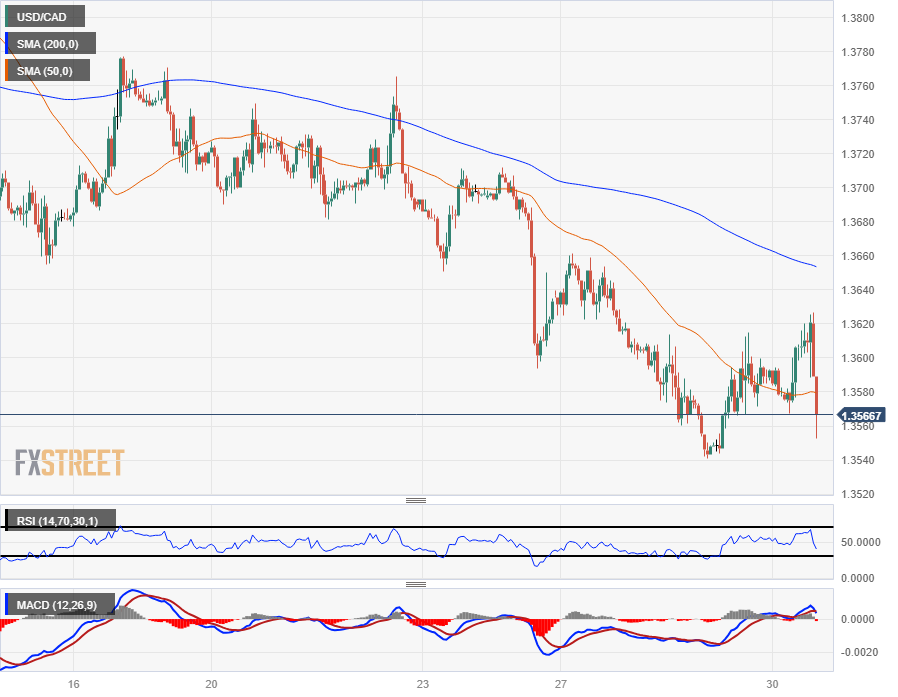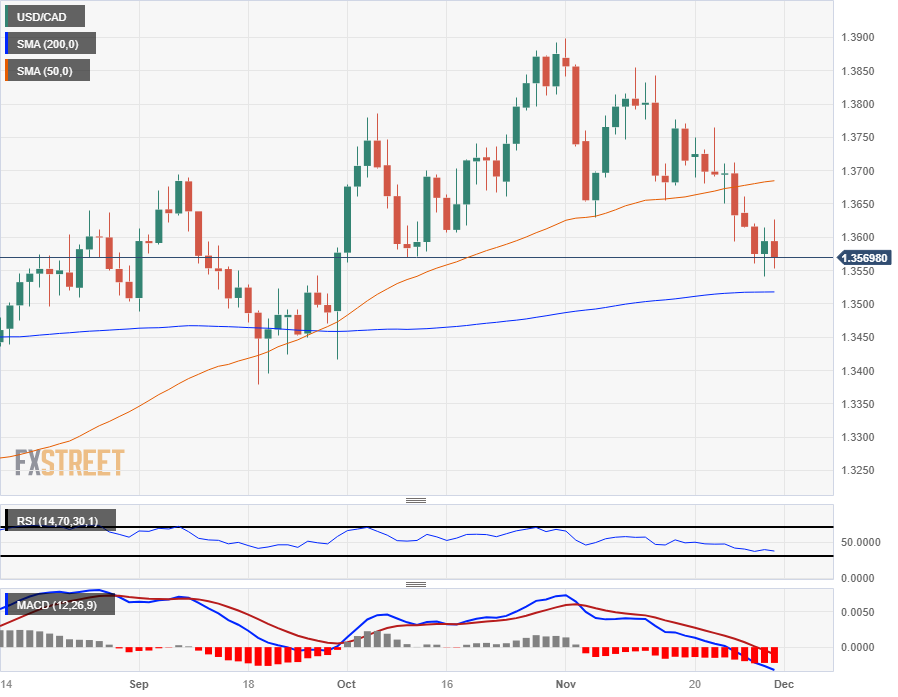- Phân tích
- Tin tức và các công cụ
- Tin tức thị trường
- Canadian Dollar rallies into the green on Thursday despite mixed Canadian GDP results
Canadian Dollar rallies into the green on Thursday despite mixed Canadian GDP results
- The Canadian Dollar is seeing a broad-market push higher.
- Canadian GDP mixed, but the underlying revisions are helping to bolster the CAD.
- OPEC supply cuts to prop up Crude Oil markets, underpin Loonie trading.
The Canadian Dollar (CAD) is catching a batch of bids during Thursday’s US trading session, bolstered by climbing Crude Oil. The Canadian Dollar is the single best-performing of the major currency bloc, in the green against every single one of its major currency peers as the Loonie heads into the last quarter of the Thursday trading day.
Canadian Gross Domestic Product (GDP) came in mixed but leaning positive in the near-term data, and Crude Oil is lending the fossil-fueled Loonie some support. The Organization of the Petroleum Exporting Countries (OPEC) unanimously agreed to additional production cuts with an ambiguous end date.
Daily Digest Market Movers: Canadian Dollar makes a late topside break
- The Canadian Dollar caught a late surge on Thursday to outperform the rest of the major currency bloc.
- The CAD is up three-quarters of a percent against the Japanese Yen (JPY) and the Euro (EUR), and around halfsix-tenths of a percent on the Pound Sterling (GBP) at the time of writing.
- Canadian GDP came in mixed, with the September MoM printing 0.1% above the expected flat 0.0%, while the YoY figure contracted steeply.
- Annualized third quarter Canadian GDP came in at -1.1%, sharply missing the market median forecast of 0.2% YoY growth, but the previous period’s figure did see a sharp upward revision, getting adjusted from -0.2% to 1.4%.
- Crude Oil markets are set for an upside twist after OPEC unanimously agreed (for the time being) to further cut oil output by an additional million barrels per day (bpd).
- Crude Oil price gains on the back of additional supply cuts likely to remain capped with plenty of spare capacity in global energy demand.
- OPEC is reporting that the additional production caps will last through Q1 2024.
Canadian Dollar price today
The table below shows the percentage change of Canadian Dollar (CAD) against listed major currencies today. Canadian Dollar was the strongest against the Japanese Yen.
| USD | EUR | GBP | CAD | AUD | JPY | NZD | CHF | |
| USD | 0.56% | 0.32% | -0.19% | -0.07% | 0.57% | -0.26% | -0.26% | |
| EUR | -0.56% | -0.26% | -0.74% | -0.66% | 0.01% | -0.84% | -0.82% | |
| GBP | -0.32% | 0.25% | -0.48% | -0.39% | 0.28% | -0.58% | -0.55% | |
| CAD | 0.19% | 0.74% | 0.49% | 0.09% | 0.76% | -0.08% | -0.08% | |
| AUD | 0.07% | 0.66% | 0.41% | -0.09% | 0.68% | -0.17% | -0.17% | |
| JPY | -0.58% | 0.00% | -0.26% | -0.74% | -0.70% | -0.80% | -0.80% | |
| NZD | 0.28% | 0.83% | 0.59% | 0.08% | 0.19% | 0.85% | 0.01% | |
| CHF | 0.32% | 0.80% | 0.54% | 0.06% | 0.18% | 0.80% | -0.04% |
The heat map shows percentage changes of major currencies against each other. The base currency is picked from the left column, while the quote currency is picked from the top row. For example, if you pick the Euro from the left column and move along the horizontal line to the Japanese Yen, the percentage change displayed in the box will represent EUR (base)/JPY (quote).
Technical Analysis: Canadian Dollar lurches higher on the day, sends the USD/CAD back below 1.3600
The Canadian Dollar (CAD) initially fell back against the US Dollar (USD) in Thursday trading with the pair reaching a three-day high of 1.3626, but the CAD’s late break sent the pair back below the 1.3600 handle to test the waters near 1.3550.
Intraday chart action continues to be capped by the 200-hour Simple Moving Average (SMA) descending into 1.3650 while the 50-day SMA is drawing prices into the near-term midrange around 1.3580.
Daily candlesticks have the USD/CAD pair struggling to make downside progress towards the 200-day SMA just above 1.3500, and the CAD is struggling to carve out further downside territory against the USD despite Thursday’s Loonie push.
USD/CAD Hourly Chart

USD/CAD Daily Chart

Canadian Dollar FAQs
What key factors drive the Canadian Dollar?
The key factors driving the Canadian Dollar (CAD) are the level of interest rates set by the Bank of Canada (BoC), the price of Oil, Canada’s largest export, the health of its economy, inflation and the Trade Balance, which is the difference between the value of Canada’s exports versus its imports. Other factors include market sentiment – whether investors are taking on more risky assets (risk-on) or seeking safe-havens (risk-off) – with risk-on being CAD-positive. As its largest trading partner, the health of the US economy is also a key factor influencing the Canadian Dollar.
How do the decisions of the Bank of Canada impact the Canadian Dollar?
The Bank of Canada (BoC) has a significant influence on the Canadian Dollar by setting the level of interest rates that banks can lend to one another. This influences the level of interest rates for everyone. The main goal of the BoC is to maintain inflation at 1-3% by adjusting interest rates up or down. Relatively higher interest rates tend to be positive for the CAD. The Bank of Canada can also use quantitative easing and tightening to influence credit conditions, with the former CAD-negative and the latter CAD-positive.
How does the price of Oil impact the Canadian Dollar?
The price of Oil is a key factor impacting the value of the Canadian Dollar. Petroleum is Canada’s biggest export, so Oil price tends to have an immediate impact on the CAD value. Generally, if Oil price rises CAD also goes up, as aggregate demand for the currency increases. The opposite is the case if the price of Oil falls. Higher Oil prices also tend to result in a greater likelihood of a positive Trade Balance, which is also supportive of the CAD.
How does inflation data impact the value of the Canadian Dollar?
While inflation had always traditionally been thought of as a negative factor for a currency since it lowers the value of money, the opposite has actually been the case in modern times with the relaxation of cross-border capital controls. Higher inflation tends to lead central banks to put up interest rates which attracts more capital inflows from global investors seeking a lucrative place to keep their money. This increases demand for the local currency, which in Canada’s case is the Canadian Dollar.
How does economic data influence the value of the Canadian Dollar?
Macroeconomic data releases gauge the health of the economy and can have an impact on the Canadian Dollar. Indicators such as GDP, Manufacturing and Services PMIs, employment, and consumer sentiment surveys can all influence the direction of the CAD. A strong economy is good for the Canadian Dollar. Not only does it attract more foreign investment but it may encourage the Bank of Canada to put up interest rates, leading to a stronger currency. If economic data is weak, however, the CAD is likely to fall.
© 2000-2024. Bản quyền Teletrade.
Trang web này được quản lý bởi Teletrade D.J. LLC 2351 LLC 2022 (Euro House, Richmond Hill Road, Kingstown, VC0100, St. Vincent and the Grenadines).
Thông tin trên trang web không phải là cơ sở để đưa ra quyết định đầu tư và chỉ được cung cấp cho mục đích làm quen.
Giao dịch trên thị trường tài chính (đặc biệt là giao dịch sử dụng các công cụ biên) mở ra những cơ hội lớn và tạo điều kiện cho các nhà đầu tư sẵn sàng mạo hiểm để thu lợi nhuận, tuy nhiên nó mang trong mình nguy cơ rủi ro khá cao. Chính vì vậy trước khi tiến hành giao dịch cần phải xem xét mọi mặt vấn đề chấp nhận tiến hành giao dịch cụ thể xét theo quan điểm của nguồn lực tài chính sẵn có và mức độ am hiểu thị trường tài chính.
Sử dụng thông tin: sử dụng toàn bộ hay riêng biệt các dữ liệu trên trang web của công ty TeleTrade như một nguồn cung cấp thông tin nhất định. Việc sử dụng tư liệu từ trang web cần kèm theo liên kết đến trang teletrade.vn. Việc tự động thu thập số liệu cũng như thông tin từ trang web TeleTrade đều không được phép.
Xin vui lòng liên hệ với pr@teletrade.global nếu có câu hỏi.















